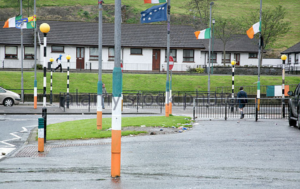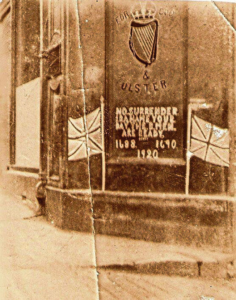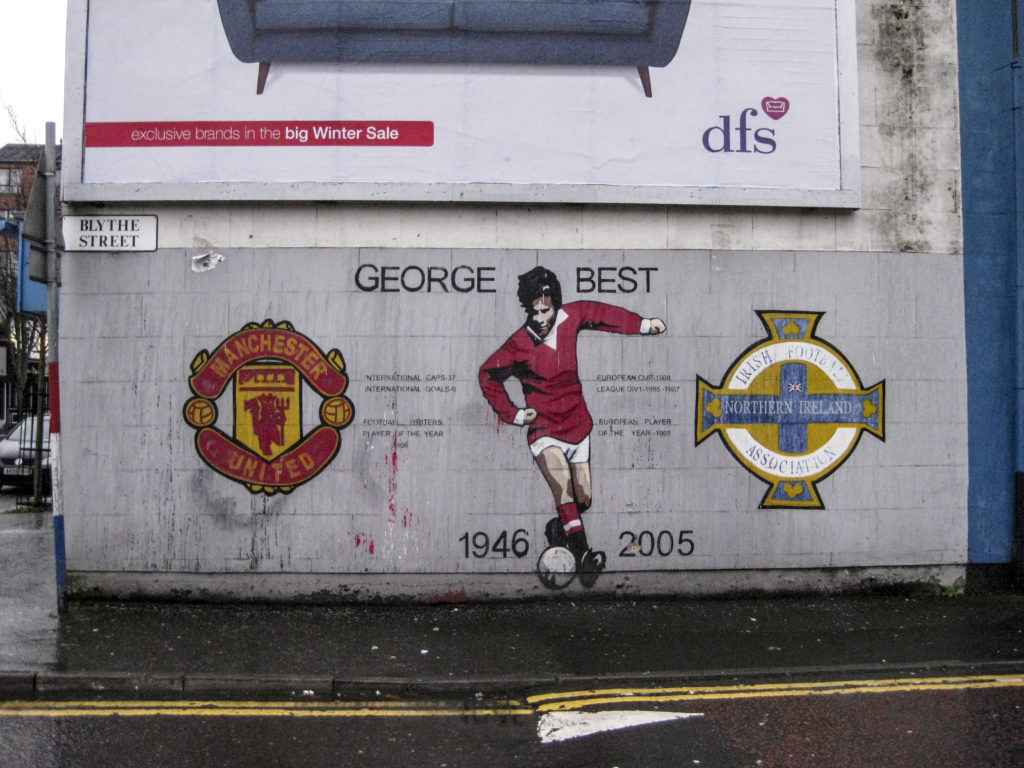
“Love, peace, and happiness–is this possible in Belfast?” Discuss! We will try to answer this question as we tour the city and talk to its people Belfastians are very fond of writing and painting on the gable ends of houses and other blank canvasses in their city. Obviously, they have a lot to say! On our city tour of Belfast we will be visiting Loyalist and Republican neighborhoods to see the famous political murals that are a must-see in the city. For nearly a century, these public artworks—and many of them are indeed works of art—have proclaimed a city, a region in conflict–violent, militaristic conflict.

With Republican murals sporting the green, orange and white of the tricolor flag of the Republic of Ireland (a “flag of a foreign country” in some Loyalists’ eyes) and Loyalist murals reiterating the red, white, and blue of the Union Jack, there’s no mistaking where you are. If you still don’t know, look at the lampposts and curbs for additional colorful evidence of which side lives here. The presence in the mural paintings of masked armed men pointing serious guns at the viewer, scenes of conflict from various attacks and bombings, and obscure (to the tourist) references to heroes and battles from the thirty years of the Troubles and from even earlier history has let everyone know for a very long time that this a divided, broken society at war with itself.
Until now.
Since the Belfast Peace Agreement of 1998 and mores specifically since 2006 and the establishment of the “Reimaging Cities Commission” by the government of the province, the city’s murals have begun a gradual but welcome (to most, not all) transformation.

As you might imagine in a divided society, not everyone is happy with this change. To some, it means “erasing history.” Sound familiar? We have our own struggles in the US regarding what should be done with memorials erected to commemorate the Confederate States of America and its legacy of condoning slavery. Other Belfastians argue that murals have always depicted the concerns and aspirations of the community, and those tend to shift over time. Murals by their nature change, this argument runs, and that change is healthy.
Here is an example of an older Loyalist mural with images of masked gunmen and paramilitary insignias that has been recently replaced by a Loyalist mural of a very different kind.
The second mural–on the very same building–looks to ancient mythology, not the recent conflict, for a message that still speaks to a Loyalist identity (protestant, Ulster, ownership of the land) but does so in less incendiary terms. The severed hand on the beach may look like a result of battle, but the image goes back to a very old mytho-historical tale about a king and his two sons who were sailing to some part of Ulster to take it over. The king told his sons that whoever touched the land first would be its ruler. One son leaped out of the boat and swam as fast as he could towards land. Surely he would be the eventual ruler! But the second son took a more canny, if also more painful, approach. With a swipe of his sword, he cut off his hand and threw it onto the beach, thus “touching” land before his brother and winning the competition.

This story is said to be the origin of the “red hand of Ulster,” a symbol used by Loyalists in modern times to signal the importance to them of land, of Ulster itself, and what they are willing to do to keep it. It’s still violent, still bloody, still Loyalist, but it’s not a masked gunman aiming his rifle at you or your children as they walk to school in the morning. Interestingly, because the red hand of Ulster story dates back to the early middle ages or earlier, therefore preceding any hint of sectarian divide, the story, the red hand, and the desperate claim of land ownership resonate with Republicans as well. After all, they see England as having “taken” their land from them, and they would still like to win back those six counties that make up Northern Ireland.
Here’s another example of an older, rather frightening mural, being replaced with a softer though still military image. The first mural depicts a soldier bringing death (see the reaper in the background) to his enemies, presumably at the Battle of the Somme, where the Ulster troops died in massive numbers fighting for Britain. The replacement image hearkens back to a safer historical moment: Britain’s King William (Britain and protestant Ireland) defeating King James II (Jacobites and French)–Protestantism defeating Catholicism–at the Battle of the Boyne north of Dublin in 1690. King Billy is favorite Loyalist icon, The image of him here may derive from a battle, but it is more about bravery and horsemanship than it is about killing your opponents. Remember, these images appeared one after the other on the same gable end of a house in Belfast, a transformation that must have been perceived as dramatic by the locals.
Along with mythological images, pictures of sports stars and other cultural icons are appearing throughout the city. George Best, a famous footballer who died young, appears often. Since football (what we call soccer) is mostly a protestant game, the images of Best and others are not without political meaning, but at least the focus is on sports and not on paramilitary action.
Literary figures are also appearing more and more often. C. S. Lewis was born in Belfast, and though he lived in England for much of his life, Belfast claims him as a favorite son. Here is one of my favorite of the newer murals, this one celebrating the arts with a image of Lewis and one of his most famous quotations: “You are never told to set another goal or to dream a new dream.”
On the Republican side of town, the newer murals tend to celebrate human rights in various ways, to align the Republican cause with other rights struggles around the world, or to critique world events. The mural below is a favorite with Agnes Scott students, and we like to quiz them on the many world human rights figures pictured. The man in the center–Frederick Douglass–visited Belfast in 1845 and enjoyed his stay there very much, as his letters home indicate. He had just published his memoir of his life as a slave; the book caused a stir at home, and friends recommended that he go abroad to flee the furor. As a runaway slave, he could have easily been caught and re-enslaved in the US. Ireland and England proved more welcoming.

The next one is also in a Republican section of town and takes up the cause of climate change.

As an outsider to the conflict, I certainly welcome the change and side with those who see murals as, by their nature, evolving with the community’s needs and desires. We’ll see some murals that still represent the armed conflict and many others that show the new Belfast. Either way, there will be a lot to learn and “Discuss.”
To learn more, here are two interesting reports about the murals.
Art of Conflict: Northern Ireland ‘s street murals (2013)
Northern Ireland’s Troubles: Walls of Shame (2016)







If the crown prince of England can love and marry an American woman of color, peace in Ireland is surely possible. As a freshman at ASC, it was said that the east coast was still fighting the Civil War. Perhaps true. Now a permanent resident in one of the largest melting pots in the world, I see the most unlikely of ethnic groups love each other.